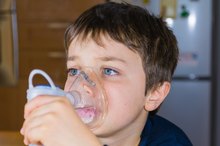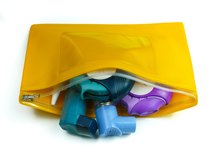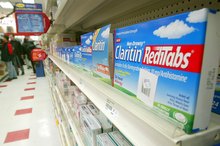How Long Does It Take for an Allergy Medicine to Work?
Allergies are a reaction of the immune system to harmless substances. Allergies may cause nasal symptoms, hives, asthma or even anaphylaxis, a severe form of allergy that may be fatal. Most mild allergies can be controlled with simple, symptomatic treatments. The most important form of treatment, however, is for individuals to avoid the various foods, pollen, insect bites or other substances to which they may be allergic. Individuals with allergies should consult with their medical practitioner before starting treatment to ensure they are getting the best possible allergy control.
If you are experiencing serious medical symptoms, seek emergency treatment immediately.
Antihistamines
Antihistamines are used to treat a variety of allergic reactions. Histamine is an important chemical released during allergic reactions, and these medications work against this chemical. They are effective, for example, in the treatment of skin allergies and hay fever. Newer generation antihistamines offer allergy relief while causing minimal sleepiness 1. These medications typically begin to work within one and two hours. While asthma is also an allergic condition, antihistamines are not useful in the treatment of this disorder 1.
- Antihistamines are used to treat a variety of allergic reactions.
- Histamine is an important chemical released during allergic reactions, and these medications work against this chemical.
Steroids
List of Nebulizer Medications and Ingredients
Learn More
Steroids are also highly effective medications for treating allergic reactions. In contrast to antihistamines, however, steroids have a more gradual, but long-lasting, onset of action. Fluticasone, a steroid used as a nasal spray in the treatment of hay fever, takes a minimum of eight hours to be effective. However, the advantage of steroids is that they reduce the overall symptoms of allergy for extended periods of time. Steroids treat both nasal and eye symptoms. These medications also decrease the severity and the frequency of asthma attacks.
- Steroids are also highly effective medications for treating allergic reactions.
- However, the advantage of steroids is that they reduce the overall symptoms of allergy for extended periods of time.
Cromolyn Sodium
Cromolyn sodium is an alternative medication for allergies. It is used for conditions such as asthma, allergy-induced pink eye and allergic nasal symptoms 1. While steroids are stronger and more effective to treat allergies, they may cause long-term complications such as weight gain, decreased immunity and weakened bones. Doctors may prescribe cromolyn as an alternative to a steroid. Unfortunately, the medication is slow to act; it may take up to four weeks for any improvement to occur with this medication.
- Cromolyn sodium is an alternative medication for allergies.
Leukotriene Antagonists
Treatment for Asthmatic Bronchitis
Learn More
Leukotriene antagonists are drugs such as montelukast and zafirlukast. These medications block the action of leukotrienes, chemicals which are released as a part of an allergic reaction. As with cromolyn, these medications may be tried as an alternative to steroids for asthma and for seasonal allergies. The medication is taken orally or as an inhaler, and often provide relief within 2 days of use.
- Leukotriene antagonists are drugs such as montelukast and zafirlukast.
- As with cromolyn, these medications may be tried as an alternative to steroids for asthma and for seasonal allergies.
Related Articles
References
- Allergy and Asthma Proceedings: Onset of Action for the Relief of Allergic Rhinitis Symptoms with Second Generation Antihistamines
- Journal of the American Academy of Dermatology: Treatment of Urticaria and Angioedema -- Low Sedating H1 Antihistamines
- Journal of Asthma and Allergy: Fluticasone Furoate Nasal Spray -- Profile of an Enhanced-Affinity Corticosteroid in the Treatment of Seasonal Allergic Rhinitis
- Medline Plus: Cromolyn Sodium Nasal Solution
- Allergy and Asthma Proceedings: Onset of Efficacy of Montelukast in Seasonal Allergic Rhinitis
- Varshney J, Varshney H. Allergic Rhinitis: an Overview. Indian J Otolaryngol Head Neck Surg. 2015;67(2):143-9. doi:10.1007/s12070-015-0828-5
- Sublett JL. Effectiveness of air filters and air cleaners in allergic respiratory diseases: a review of the recent literature. Curr Allergy Asthma Rep. 2011;11(5):395-402. doi:10.1007/s11882-011-0208-5
- Lyons JJ, Milner JD, Stone KD. Atopic dermatitis in children: clinical features, pathophysiology, and treatment. Immunol Allergy Clin North Am. 2015;35(1):161-83. doi:10.1016/j.iac.2014.09.008
- Mesquita Kde C, Igreja AC, Costa IM. Atopic dermatitis and vitamin D: facts and controversies. An Bras Dermatol. 2013;88(6):945-53. doi:10.1590/abd1806-4841.20132660
- Shaker D. An Analysis of “Natural” Food Litigation to Build a Sesame Allergy Consumer Class Action. Food Drug Law J. 2017;72(1):103-40.
- Sicari V, Zabbo CP. Diphenhydramine. StatPearls Publishing. Updated April 28, 2019.
- Dokuyucu R, Gokce H, Sahan M, et al. Systemic side effects of locally used oxymetazoline. Int J Clin Exp Med. 2015;8(2):2674-8.
- Small P, Keith PK, Kim H. Allergic rhinitis. Allergy Asthma Clin Immunol. 2018;14(Suppl 2):51. doi:10.1186/s13223-018-0280-7
- Hong J, Buddenkotte J, Berger TG, Steinhoff M. Management of itch in atopic dermatitis. Semin Cutan Med Surg. 2011;30(2):71-86. doi:10.1016/j.sder.2011.05.002
- Kariyawasam HH, Scadding GK. Seasonal allergic rhinitis: fluticasone propionate and fluticasone furoate therapy evaluated. J Asthma Allergy. 2010;3:19-28.
- Nowicki R, Trzeciak M, Wilkowska A, et al. Atopic dermatitis: current treatment guidelines. Statement of the experts of the Dermatological Section, Polish Society of Allergology, and the Allergology Section, Polish Society of Dermatology. Postepy Dermatol Alergol. 2015;32(4):239-49. doi:10.5114/pdia.2015.53319
- Keet C. Recognition and management of food-induced anaphylaxis. Pediatr Clin North Am. 2011;58(2):377-88, x. doi:10.1016/j.pcl.2011.02.006
- InformedHealth.org. Medication for people with asthma. Cologne, Germany: Institute for Quality and Efficiency in Health Care (IQWiG). Updated November 30, 2017.
- Pera T, Penn RB. Bronchoprotection and bronchorelaxation in asthma: New targets, and new ways to target the old ones. Pharmacol Ther. 2016;164:82-96. doi:10.1016/j.pharmthera.2016.04.002
- Moote W, Kim H. Allergen-specific immunotherapy. Allergy Asthma Clin Immunol. 2011;7 Suppl 1:S5. doi:10.1186/1710-1492-7-S1-S5
- Nasim F, Iyer VN. Bronchial thermoplasty-an update. Ann Thorac Med. 2018;13(4):205-211. doi:10.4103/atm.ATM_365_17
- George M, Topaz M. A systematic review of complementary and alternative medicine for asthma self-management. Nurs Clin North Am. 2013;48(1):53-149. doi:10.1016/j.cnur.2012.11.002
- Kohn CM, Paudyal P. A systematic review and meta-analysis of complementary and alternative medicine in asthma. Eur Respir Rev. 2017;26(143):53-149. doi:10.1183/16000617.0092-2016
- Land MH, Wang J. Complementary and Alternative Medicine Use Among Allergy Practices: Results of a Nationwide Survey of Allergists. J Allergy Clin Immunol Pract. 2018;6(1):95-98.e3.
Writer Bio
Sriram Ramgopal is a medical graduate from Sri Ramachandra University, India. He currently lives in the the greater Boston area and works as a Neurology Research Fellow at Children's Hospital, Boston. Ramgopal is also the co-founder of Sangam India, a nonprofit urban development organization based in Chennai, India.








